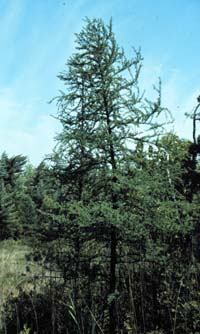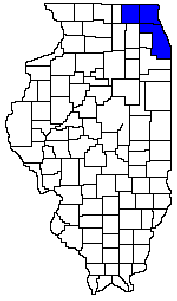 |
| Tamarack
(Larix laracina)
Distribution
Map to Right |

Tamarack, also commonly referred to as American larch or larch, is a deciduous conifer (bearing cones) with needle-like leaves that are shed in the fall. It typically grows to heights between 40 and 80 feet, but may reach heights of 100 feet. The trunk is straight, with a diameter of up to 1 1/2 feet. The crown is narrow and conical.
Tamarack has one of the widest ranges of the American conifers. It occurs in bogs, fens, and swamps from Labrador to Alaska, south to Minnesota, Northern Illinois and West Virginia. It thrives on acidic, poorly drained soils and does not tolerate warmer climates or dry substrates, although it occurs occasionally on slightly drier sites in New England. In Illinois, it occurs in three of the northeastern-most counties in wet kettle hole depressions, fens, and shrub swamps.
Interesting
Fact
Tamarack
is a common tree in bogs and fens. It grows rapidly under favorable conditions,
but is often stunted in the northern parts of its range and under nutrient-poor
conditions. It is also stunted on mountain slopes as a result of harsh
environmental conditions. The wood of the slower-growing trees is high
in tannin, which has been used for tanning leather. The needles of larch
turn a beautiful golden color in autumn, and the tree is sometimes planted
as an ornamental. European larch (Larix decidua), a non-native species,
is also commonly planted in the landscape. It resembles American
larch, but has drooping branches, longer needles, and bark with large plates.
Identifying Features
Bark
Tamarack has reddish to grayish brown, thin, scaly bark.
Twigs
The twigs are light brown or reddish brown and smooth.
Buds
The buds are small, spherical, and have loose scales.
Leaves
The best distinguishing feature of larch is its deciduous needles, which are clustered in spirals on "spur" shoots. They appear to be small tufts of needles along the twig. The needles are three-sided and up to 1 inch long. They are light green at the beginning of the growing season, turning slightly darker later in the season. In the autumn the needles turn golden and are eventually shed.
Fruits
The cones are oblong, 1/2 to 1 inch long, reddish-brown (becoming brown with age), and are borne on the twig upright, either without a stalk or on a small, curved stalk. The scales are rounded and stiff.
Uses
Tamarack
wood is used for fence posts, interior finishing, and railroad ties. It
was formerly used in boat building. The tannin in its bark has been used
for tanning leather. Although it is fast growing under ideal circumstances,
it is not widely used as a commercial tree because of its susceptibility
to insect damage and disease. It is sometimes planted as an ornamental.